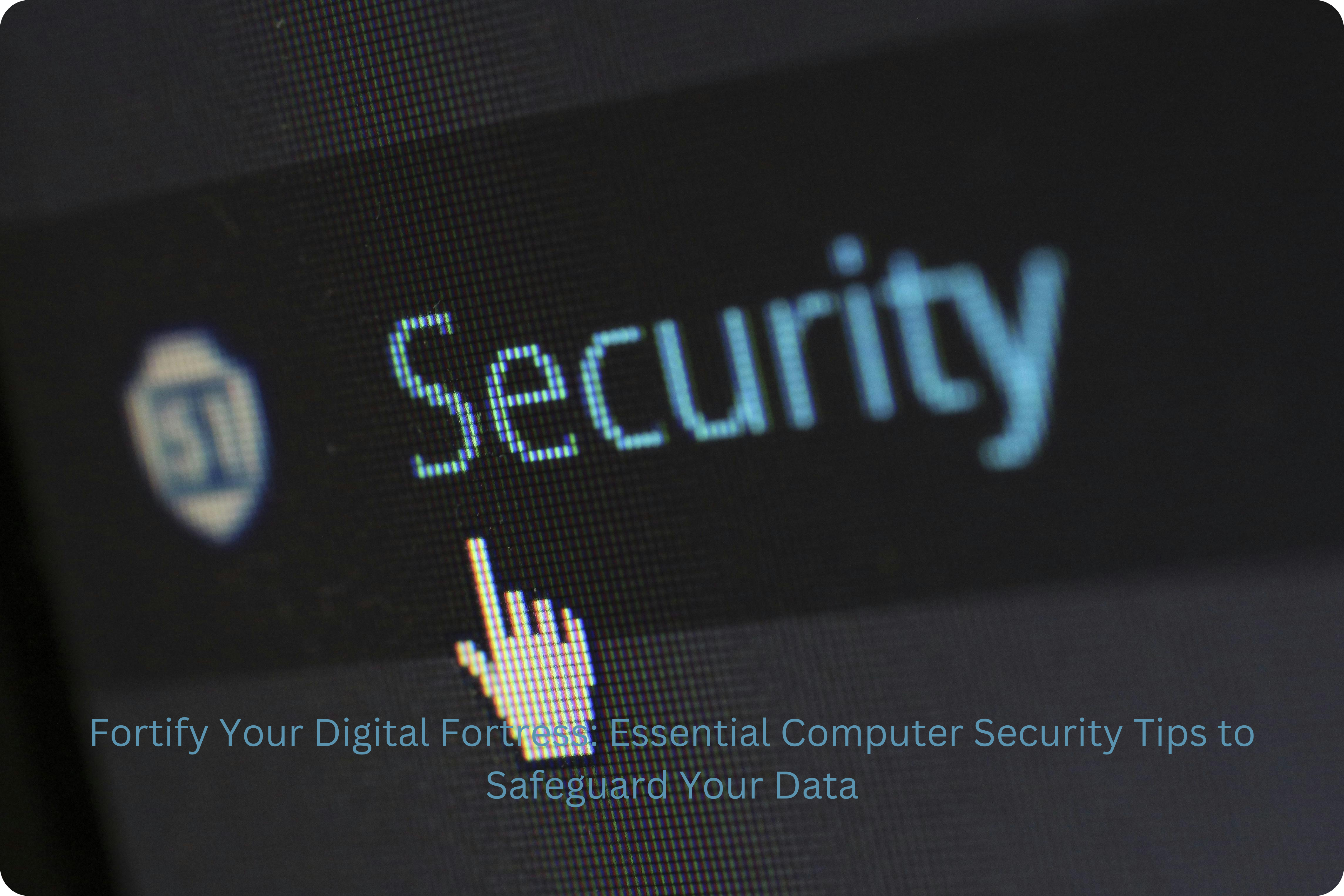Welcome to our blog, where we explore the intricate world of computer security. In this digital era, where technology plays an indispensable role in our lives, it’s crucial to understand the importance of safeguarding our sensitive data from potential threats. From malicious hackers to insidious malware, the virtual landscape is filled with lurking dangers. In this article, we will delve into essential tips and practices that can fortify your digital fortress, ensuring the integrity and security of your computer system. So, let’s dive in and empower ourselves with the knowledge to stay one step ahead in the realm of computer security.
Understanding the Threat Landscape
In order to effectively protect your computer system, it’s essential to have a clear understanding of the various threats that exist in the digital realm. The ever-evolving threat landscape encompasses a wide range of risks, including:
- Malware: Malicious software designed to infiltrate and damage your computer system, such as viruses, trojans, worms, and ransomware.
- Social Engineering: Psychological manipulation techniques used by cybercriminals to deceive individuals into divulging sensitive information or performing actions that may compromise their security.
- Phishing: Deceptive emails, messages, or websites that appear to be from reputable sources, aiming to trick users into revealing personal information, passwords, or financial details.
- Brute Force Attacks: Automated attempts to guess passwords or encryption keys by systematically trying all possible combinations until the correct one is found.
- Zero-day Exploits: Vulnerabilities or weaknesses in software that are unknown to the vendor and can be exploited by hackers before a patch or fix is released.
By familiarizing yourself with these threats, you can better understand the potential risks and implement effective countermeasures to safeguard your computer system.
Essential Computer Security Measures
Protecting your computer system requires a multi-layered approach that combines both hardware and software solutions. Here are some essential measures to consider:
1. Keep Your Operating System and Software Up to Date
Regularly updating your operating system (OS) and software is crucial as updates often include security patches that address known vulnerabilities. Enable automatic updates whenever possible to ensure you have the latest protection.
2. Install a Reliable Antivirus Software
Invest in a reputable antivirus software that offers real-time protection against malware. Regularly update the virus definitions and configure the software to perform scheduled scans of your system.
3. Enable Two-Factor Authentication (2FA)
Two-factor authentication adds an extra layer of security by requiring users to provide an additional verification factor, such as a unique code sent to their mobile device, along with their password. Enable 2FA whenever available, especially for sensitive accounts.
4. Use Strong and Unique Passwords
Choose strong, complex passwords that include a combination of uppercase and lowercase letters, numbers, and special characters. Avoid using the same password for multiple accounts and consider using a reliable password manager to securely store your credentials.
5. Regularly Back Up Your Data
Regularly backing up your important data is crucial in case of a security breach or system failure. Store backups in a secure location, preferably offline or in the cloud, and test the restoration process periodically to ensure data integrity.
By implementing these essential security measures, you can significantly strengthen the protection of your computer system and mitigate many potential risks.
Practicing Safe Online Behavior
While having robust security measures in place is crucial, it’s equally important to practice safe online behavior to minimize the risk of falling victim to cyber threats. Here are some best practices to follow:
1. Exercise Caution When Clicking Links or Downloading Files
Avoid clicking on suspicious links or downloading files from untrusted sources. Be cautious of email attachments, pop-up ads, and links shared on social media platforms. Hover over links to verify their destination before clicking.
2. Be Wary of Phishing Attempts
Stay vigilant against phishing attempts and be skeptical of unsolicited emails or messages asking for personal information or urging immediate action. Verify the legitimacy of the sender and double-check the URL of websites before providing any sensitive data.
3. Secure Your Wi-Fi Network
Ensure your home or office Wi-Fi network is password protected and uses encryption. Change the default administrator credentials for your router and regularly update its firmware to patch security vulnerabilities.
4. Be Mindful of What You Share Online
Be cautious about the personal information you share online, especially on social media platforms. Avoid sharing sensitive details like your address, phone number, or financial information publicly.
5. Educate Yourself and Stay Informed
Keep yourself updated about the latest security threats, scams, and best practices. Stay informed by following reputable technology blogs, security websites, and official sources for the most recent information.
By adopting these safe online practices, you can significantly reduce the risk of falling victim to cyberattacks and protect your sensitive information from unauthorized access.
Securing Your Physical Environment
While we often focus on digital threats, it’s important not to overlook the physical aspects of computer security. Here are some measures to secure your physical environment:
1. Lock Your Computer and Devices
When you step away from your computer or mobile device, lock the screen or enable password-protected screensavers. This prevents unauthorized access to your data when you’re not around.
2. Secure Your Workspace
Ensure that your workspace is physically secure. Lock doors and windows if possible, and consider using privacy filters on your computer screens to prevent shoulder surfing or visual eavesdropping.
3. Safeguard Portable Devices
Take extra precautions with portable devices like laptops, tablets, and smartphones. Use strong passwords or biometric authentication methods, enable remote tracking and wiping features, and never leave them unattended in public places.
4. Dispose of Data Securely
When disposing of old computers, hard drives, or other storage media, ensure that all data is securely erased. Use specialized software or physically destroy the storage media to prevent sensitive information from falling into the wrong hands.
5. Implement Physical Access Controls
Consider implementing physical access controls to limit who can enter areas where sensitive computer systems are located. This can include key cards, biometric scanners, or security guards to prevent unauthorized access.
By addressing the physical security aspects of your computer system, you add an extra layer of protection against potential threats and reduce the risk of physical compromise to your data.
Staying Vigilant: Monitoring and Incident Response
Maintaining a proactive approach to computer security involves continuous monitoring and effective incident response. Here are some key practices to consider:
1. Monitor System Logs
Regularly monitor system logs for any suspicious activities or anomalies. Unusual login attempts, unexpected network traffic, or unauthorized access attempts can indicate a security breach.
2. Use Intrusion Detection and Prevention Systems
Implement intrusion detection and prevention systems (IDPS) to actively monitor and detect potential threats. These systems can analyze network traffic, identify malicious activity, and take immediate action to prevent security breaches.
3. Conduct Regular Vulnerability Assessments
Perform routine vulnerability assessments and penetration testing to identify weaknesses in your computer system. Address any vulnerabilities promptly and ensure that all software and applications are up to date.
4. Develop an Incident Response Plan
Create a comprehensive incident response plan that outlines the steps to be taken in the event of a security breach. This includes identifying responsible individuals, establishing communication channels, and defining recovery procedures.
5. Educate and Train Employees
Train employees on security best practices, such as recognizing phishing attempts, using strong passwords, and reporting suspicious activities. Regularly educate them about emerging threats and provide ongoing security awareness training.
By staying vigilant, monitoring your systems, and having a well-defined incident response plan, you can effectively detect and respond to security incidents, minimizing the potential impact on your computer system.
In conclusion, computer security is of paramount importance in today’s digital landscape. Protecting your sensitive data and maintaining the integrity of your computer system requires a multi-faceted approach. By understanding the various threats that exist, implementing essential security measures, practicing safe online behavior, securing your physical environment, and staying vigilant through monitoring and incident response, you can significantly mitigate the risks posed by cyber threats.
Remember, computer security is an ongoing process that requires continuous attention and adaptation to emerging threats. Stay informed, keep your systems up to date, and educate yourself and your employees about the latest security practices. By doing so, you can fortify your digital fortress and enjoy a safer and more secure computing experience.
Thank you for joining us in this exploration of computer security. Stay safe, stay informed, and may your digital journey be filled with peace of mind.

